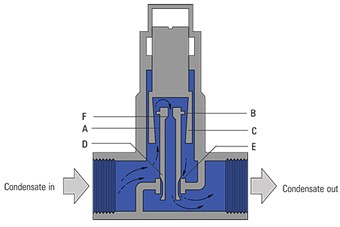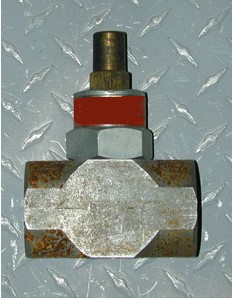Impulse Trap:
Impulse trap is classified as Kinetic energy operated traps based on its working principle. Impulse traps cannot give a dead tight shutoff and therefore the use of impulse traps is relatively limited as compared to other types available.
Construction and Working Principle of Impulse Trap:
The Impulse Trap is schematically shown in the accompanying sketch (refer Figure-1). It consists of a hollow piston A with a piston disc B working inside a tapered guide cylinder C.
 Impulse Trap |
 Fig 1- Impulse Trap |
At start the main valve D (integral part of piston A) is seated against the seat E and the flow takes place through the clearance between disc B and Cylinder C and then through the port F. An increase in the flow of fluid will act on the disc B to lift the piston A off its seat to give an increased flow of condensate through the seat. As the condensate passing between the clearance between disc B and Cylinder C tends to approach the steam temperature it flashes in the upper portion of the space between disc B and piston C. Even though the above flash steam, does bleed through the port F it still builds an intermediate pressure to push the piston A to throttle the flow of condensate through the seat. It is obvious from the above functional description that the Trap is never ever able to provide a tight shut off and will always pass some live steam specially, at light loads. Because of this inherent weakness the above trap is not a preferred choice in the current practice.
Advantages of Impulse Trap:
- Impulse traps have a substantial condensate handling capacity for their size.
- Without any change in valve size they can work over a wide range of steam pressures and also useful on high pressure and superheated steam.
- They are good at venting air and cannot ‘air-bind’.
Disadvantages of Impulse Trap:
- Impulse traps cannot give a dead tight shut-off and Continuous bleed orifice will waste steam at light loads.
- Close clearances required between various components invariably get choked due to the dirt accompanying the condensate.
- Gives rise to water logging. Hence predominantly overwhelmed with the problems of water hammer and corrosion.
- It is unsuitable for use when the back pressure is in significant proportion (approx. 40%) to the inlet p ressure.